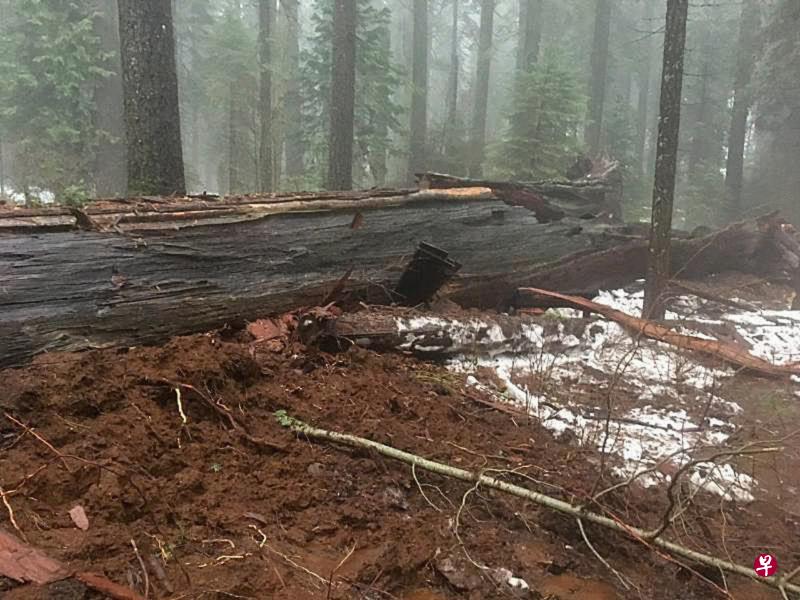(单词翻译:单击)
听力文本
This is Scientific American — 60-Second Science. I'm Christopher Intagliata.
Back in January, one of California's oldest and most iconic residents keeled over: the Pioneer Cabin tree, a giant sequoia in Calaveras Big Trees State Park...so big you used to be able to drive through it.
The giant was blown over by high winds—delivered by what's called an atmospheric river, a long stream of water vapor in the atmosphere, 100 miles wide. These systems might be thought of as some of the biggest rivers on Earth.
"You could kind of pose it that way, yeah." Duane Waliser (WALL-i-ser), an atmospheric scientist at the Jet Propulsion Lab. "An atmospheric river will carry the same amount of water vapor as, say, 15 to 20 Mississippi Rivers."

Waliser and his JPL colleague Bin Guan developed an algorithm to detect atmospheric rivers in historical data, so they could connect the sky flow to extreme events on land. And they found that, if you look at just the top 2 percent most extreme wind- and rain- and snow-storms in the world's midlatitude regions—atmospheric rivers are linked to up to half of them.
And of the 19 windstorms in Europe that cost insurance companies the most money—billions of dollars in damage—atmospheric rivers were behind three-quarters of those events. The study is in the journal Nature Geoscience.
Looking ahead, as global temperatures rise, that warmer air holds more water vapor. "And so the tendency looks like, if the climate does warm, you would tend to have stronger or more frequent atmospheric rivers." And as this study shows: it won't just be that a hard rain's gonna fall. We'll be blowing in the wind, too.
Thanks for listening for Scientific American — 60-Second Science Science. I'm Christopher Intagliata.
参考译文
这里是科学美国人——60秒科学。我是克里斯托弗·因塔利亚塔。
“先驱小屋树”是加利福尼亚州其中一颗最古老、最具代表性的树木,而它在今年1月倒塌了,这颗巨型红杉树耸立在卡拉维拉斯美洲红杉州立公园内,它大到你可以开车穿过它。
这颗巨型红杉被大气层河流产生的狂风吹倒,大气层河流是大气层中一条绵长的水汽流,宽约100英里。这些系统可能被认为是地球上最长的几条河流。
“可以这样解释。”杜恩·瓦里泽是喷气推进实验室的大气科学家。“大气层河流所携带的水蒸汽的总量约相当于15至20条密西西比河。”
瓦里泽和他在喷气实验室的同事关斌(音译)研发了一种算法来检测大气层漂流的历史数据,所以,这样一来他们可以将天空流和陆地上发生的极端现象联系起来。他们发现,如果仅看世界中纬度地区2%的极端天气,如暴风、骤雨或者暴风雪等,你会发现最多有一半的极端天气同大气层河流有关。
欧洲发生了19起让保险公司赔偿了数十亿美元的严重风暴,其中75%都与大气层河流有关。这项研究结果发表在《自然地球科学》期刊上。
未来,随着全球气温的升高,温暖的空气会携带更多的水汽。“发展趋势为,如果气候变暖,那大气层河流的强度会更高,出现的频率会更多。”正如研究结果呈现的那样:未来不仅仅是暴雨将至,我们也会随风飘荡。
谢谢大家收听科学美国人——60秒科学。我是克里斯托弗·因塔利亚塔。
译文为可可英语翻译,未经授权请勿转载!
重点讲解
重点讲解:
1. keel over (因疲劳或生病而)倒下,瘫倒;
例句:He then keeled over and fell flat on his back.
然后,他便仰天倒下了。
2. be linked to 联系;关系;关联;
例句:It is generally accepted that wages should be linked to prices.
人们普遍认为,工资应与物价联系起来。
3. look ahead 展望未来;规划未来;
例句:We are trying to look ahead and see what our options are.
我们努力着眼于未来,看我们有什么选择。
4. tend to do sth. 往往会;经常就;
例句:I tend to prefer have a holiday at seaside.
我往往更喜欢在海滨度假。


